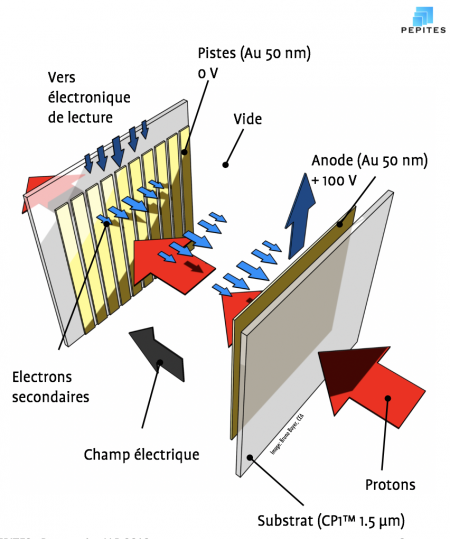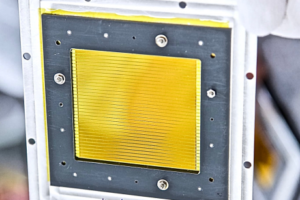PEPITES : a golden project for the Arronax beam
The PEPITES project aims to develop a detector capable of establishing a “beam diagnosis”, i.e. to collect information on the position, shape and size of a beam but also on the number of its particles. Developed for medical (proton therapy) and industrial applications, it associates the GIP Arronax, the CEA and the Laboratoire Leprince-Ringuet (UMR 7638 – École polytechnique, project leader financed by the French National Research Agency – ANR).
Insight of the beam parameters is a crucial issue for its adequate implementation. For this, position and profile have to be determined with a high degree of accuracy. These measurements may require the installation of an instrument on the trajectory of the particles. However, this type of interceptive device, located on the pathway of the beam, induces a dispersion of the beam proportional to the quantity of material crossed. One method to reduce this effect is to build a detector as slim as possible.

Fig 1 : diagram and principle of secondary electron measurements during interaction with a proton beam.
The PEPITES project proposes to develop an instrument, based on innovative materials that allow to minimize the effect of the device. A first pre-prototype has been designed and then tested on one beamline of the ARRONAX cyclotron. This step granted the proof of principle of the device operation and help to lay down the main paths for the study of such a system. The measurement signal comes from a very linear and surface phenomenon, called secondary electron emission, which allows the construction of an extremely thin sensitive zone and thus participates in the minimization of materials (see figure 1).

Fig 2 : view of the gold strips supported by the membrane
The prototype will consist of 1.5 µm thick membranes on which 50 nanometer gold strips are deposited to form the new ultra-thin monitor (see figure 2). The membrane material used has been developed for solar sails.
In 2021, the prototype will be installed on one of ARRONAX’s beamlines and will be used initially to provide feedback on the instrument’s capabilities. An intermediate step is therefore underway: the adaptation of one of the beamlines that will house the future device.
More about the PEPITES project
Contact : Freddy Poirier

